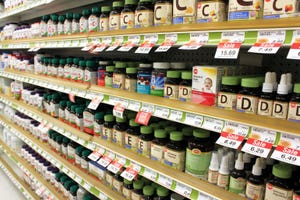Eye health is important for every life stage; nutrients can help minimize negative vision effects of modern lifestyles.

Eye health is important for every life stage, and nutrients can help minimize negative vision effects of modern lifestyles.
Carotenoids like lutein, zeaxanthin, meso-zeaxanthin and astaxanthin help improve vision by reducing cellular oxidation.
Vitamins C and E, and zinc, are also eye antioxidants, and omega-3s help reduce risks of age-related macular degeneration (AMD).
The adage that carrots are good for the eyes is certainly true; but, orange vegetables aren’t the only things that can promote healthy eye development and protect vision.
“Recent developments in technologies that allow us to measure and understand the role of key nutrients for vision have resulted with major findings,” explained John Nolan, Ph.D., principal investigator of the macular pigment research group and premier research scientist for Stauber’s Xanthosight™ carotenoid blend.
That’s good news, since optimal vision and eye health is becoming increasingly important to consumers. “Eye health has largely been a category associated with an older population to prevent age-related diseases,” said OmniActive Marketing Manager, Brian Appell. But today, “The need to protect the eyes against blue-light exposure because of our digital lifestyle is growing.” At the same time, evidence continues to mount regarding nutrients that are critical for fetal and infant eye development.
From the moment a baby is born, s/he relies on his/her eyes to take in important information, learn new things and communicate with others. Getting the right nutrients early in life sets the stage for healthy eye development in the years and decades to come. “The human visual system is not completely developed at birth and develops rapidly during the first 12 months of life,” said Gretchen Vannice, head of global nutrition education, Organic Technologies.
Later in life, key nutrients can help minimize the effects of tech-driven lifestyles. As children and younger adults engage in more screen time, the risk for eye problems can increase. Computer Vision Syndrome is marked by symptoms such as headaches, blurred vision, eye fatigue and dry eyes, according to the American Optometric Association (AOA). The culprit is the blue light emitted by devices—computers, smartphones and tablets—that penetrates deep into the eye. “The macula, the region of the eye responsible for sharp, clear vision, is most susceptible to blue light’s effects because it receives the highest concentration,” Appell explained. That can cause eye discomfort in the short term—and a gradual loss of vision over time, he added.
Nutrition can play a critical role in managing and potentially preventing eye disease that can affect older adults. Those 60 and over are most likely to be affected by age-related macular degeneration (AMD), glaucoma, cataracts and diabetic rhinopathy, said Gilbia Portela, marketing manager, Algalif. Seniors, especially women, may also be more likely to suffer from dry eyes. These conditions affect tens of millions of people today, according to the National Eye Institute—and as the population ages, the need to address these problems will continue to grow.
Nutrients for eye health
Top nutrients that contribute to vision health tend to work through one of two important mechanisms. Certain vitamins and minerals have noted antioxidant functions, and can also exert an anti-inflammatory effect. “These nutrients can decrease oxidative stress and reduce inflammatory events, and are important in all age groups,” said Mal Evans, Ph.D., scientific director, KGK Science.
If you’ve ever wondered why carrots are always credited as the go-to food for sharper vision, carotenoids are the reason. Pigments and potent antioxidants, carotenoids like lutein, zeaxanthin, and meso-zeaxanthin are the main nutrients present in the eye.
This trio works by preventing the retina from absorbing too much harmful blue light, as well as scavenging harmful free radicals. But, macular pigment carotenoids work best when they’re present in eyes at the right ratio, said Staub’s Nolan. Thanks to the CREST Vision study, there’s now firm evidence that supplementing with macular carotenoids in a ratio of 10 mg of meso-zeaxanthin, 10 mg of lutein and 2 mg of zeaxanthin shows demonstrable improvement in vision among people with healthy eyes.1
These carotenoids also benefit those with AMD. In a separate CREST study of adults with early-stage AMD, nearly 35% of participants who took 10 mg of meso-zeaxanthin, 10 mg of lutein and 2 mg of zeaxanthin showed clinically meaningful improvements in their vision after 24 months.2 Only 19% of participants taking lutein and zeaxanthin reaped those same benefits.
Another antioxidant carotenoid, astaxanthin, can neutralize free radicals in the eye.3 It “helps replenish the cells of the body, eye cells included, by capturing the oxidants produced due to excessive usage of [electronic] devices or for aging eyes that need protection from damage,” said Karen Hecht, Ph.D., scientific affairs manager, AstaReal Inc. “It also helps muscles in the eye endure the stress of long screen time.”
Studies show regular supplementation with astaxanthin can deliver a host of benefits. Taking 12 mg daily for four weeks improved blood flow in eye capillaries.4 Daily supplementation can also improve symptoms of Computer Vision Syndrome, including greater accommodation speed in subjects with eye fatigue,5 increased critical flicker fusion and sharper visual sensation.6 That can translate to improved comfort for screen users.
Along with carotenoids, omega-3 polyunsaturated fatty acids such as docosahexaenoic acid (DHA) and eicosapentaenoic acid (EPA) are among other top nutrients for eye health that can benefit people of all ages. “DHA is required in utero and through the lifespan,” Vannice said.
Randomized clinical trials reported better visual maturation and function at one year of age in babies fed formula supplemented with 0.36% DHA.7 One clinical trial reported visual acuity of infants fed formula supplemented with 0.32% DHA was like breast-fed infants at four years of age.8
Omega-3s are also effective for combatting dry eye, which can strike after extended periods of screen time. Controlled human research studies have shown consuming 750 to 2,240 mg of EPA and DHA per day increases the production and volume of tear film, and slows rate of evaporation.9,10,11 That can help ease uncomfortable symptoms like burning and irritation.
These nutrients are also thought to be important in reducing the risk for AMD. Omega-3 fatty acids have been shown to provide neuroprotection in the retina through modulating metabolic processes that affect harmful oxidative stress, inflammation and vascularization,12 Evans explained.
Large quantities of vitamin E, a family of eight fat-soluble antioxidants including alpha-tocopherol, are also present in lens fibers and membranes.13 Alpha-tocopherol can attack free radicals and prevent a chain reaction of lipid concentration, Evans said. The downside is vitamin E’s antioxidant properties are lost as soon as alpha-tocopherol neutralizes a free radical. But, other antioxidants such as vitamin C can help regenerate its antioxidant ability.14
Zinc is highly concentrated in the retina and the choroid (the vascular layer of the eye), so it, too, plays an important role in keeping eyes healthy. “It helps bring vitamin A from the liver to the retina to produce a protective pigment called melanin,” Evans said. Not getting enough zinc has been linked to impaired vision and poor night vision, as well as cloudy cataracts.15
Zinc also boasts antioxidant properties that scavenge superoxide radicals to help keep eye tissue healthy. Indeed, loss of zinc from biological membranes increases eyes’ susceptibility to oxidative damage.16 Over time, this could ultimately have a negative effect on eye function.
A look into the future
A growing number of consumers would benefit from nutritional support for optimal vision. At the same time, growing consumer awareness regarding diet and the importance of proactive health habits is likely to fuel the demand for eye heath supplements, Portela said.
Supplement manufacturers have an opportunity to educate consumers on the best options for promoting eye health. In a survey of 1,000 Baby Boomers conducted by the Ocular Wellness & Nutrition Society, almost 80% said vision is the most important of the five senses, and 55% were very concerned about vision loss. However, more than 60% were unaware that certain nutrients play key roles in maintaining eye health, and less than 20% took supplements for their eyes.
A whopping 80% of visual impairment, including blindness, is thought to be preventable, according to the World Health Organization. “The saying ‘prevention is better than cure’ has never been more accurate,” said Brian See, business development manager, ExcelVite Inc.
For a list of references, email [email protected].
A former food editor, Marygrace Taylor is an award-winning health and nutrition writer specializing in natural living. She writes for consumer and trade publications including Prevention, FITNESS and Food Service Director, and is the co-author of the cookbook “Allergy-Friendly Food for Families.”
About the Author(s)
You May Also Like




.png?width=800&auto=webp&quality=80&disable=upscale)